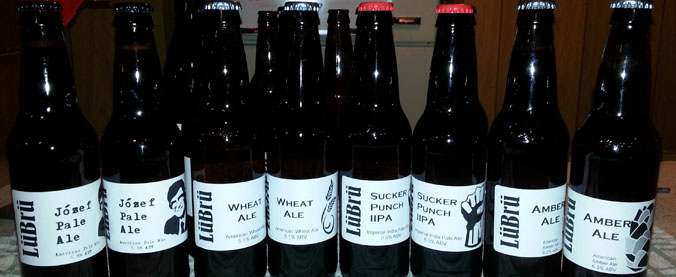
How We Brew
We currently are brewing "all grain" using a single tier,3 vessel, temperature controlled HERMS brewing system. This system was completely designed and built in my garage by both Ray and Bob(myself). This system is capable of producing a maximum of 12 gallon batches, but we mostly stick to 6 and 10 gallon sizes. HERMS stands for Heat Exchanged Recirculation Mash System. It sounds more complicated than it actually is. Basically we use a large 1/2 barrel keg filled with hot water with a copper coil in it to maintain the temperture of our steeping grain(more on that later). This is roughly the same process that any large scale brewery uses to produce their beer. Our system consists of 3 vessels:
- This vessal contains a large volume of hot water for the brewing process as well as a copper coil for the temperature control.
- This vessel is used to mix crushed brewers grain with hot water.
- This is where the beer(or wort) is made.

We start the brew day by filling both the brew kettle and the HLT with filtered water and fire the burners.
Once both vessels are at temperature, we empty the hot water from the brew kettle into the MLT. We crush our grain and add it to the hot water, making sure to mix it throughly. We then set the temerature we want maintained on our PID controller and start the recirculation pump. The HERMS system now will automatically turn the burner on and off for the HLT according to what the temperature probe is reading. It is very critical to maintain an even temperature thoughout the "mashing" process. This ensures proper starch to sugar conversion.
Once a set period of "mashing" has elapsed(usually 60 min), we then start draining the MLT into the brew kettle. As we are draining the MLT we also start slowly pumping clean hot water from the HLT onto the top of the mashed grain. This washes or rinses the remaining sugars from the grain.
Once we have collected enough wort(sugary liquid) into the brew kettle we start heating until boiling. Once at a boil, our boil timer starts. Depending on the recepie, at different times we add hops and other flavorings.
Now that the boil is complete we have to cool the wort as quickly as possible to prevent the chance of infection. We are now using a Plate chiller from Blichman Engineering to achieve this. A plate chiller uses alternating plates filled with hot wort and cold water running in opposite directions to achieve an extremely fast rate of chilling. Normally we can chill a 10 gallon batch of beer from 200 degrees to 70 dregrees as fast as we can pump the wort through.
We then fill our fermentation vessel with the cooled wort and pitch our yeast. The yeast does its yeasty thing and walla! We have beer!

We keg the beer, add some co2 for carbonation and enjoy!

Yes, the process is a bit more complicated than I stated above, but I hit most of the highlights.
